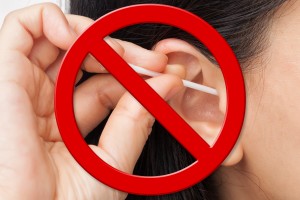 For years people have been using Q-tips to clean earwax from their ears, even though doing so is unsafe. There is even a warning label on each package telling people not to do so. Dr. Christopher T. Jones of Charlotte Eye Ear Nose & Throat Associates, P.A. joins us this month to talk about the dangers of cleaning your ears with Q-tips and why earwax is actually good for you.
For years people have been using Q-tips to clean earwax from their ears, even though doing so is unsafe. There is even a warning label on each package telling people not to do so. Dr. Christopher T. Jones of Charlotte Eye Ear Nose & Throat Associates, P.A. joins us this month to talk about the dangers of cleaning your ears with Q-tips and why earwax is actually good for you.
Why is it so unsafe to stick Q-tips in your ears?
Placing Q-tips in your ear is unsafe for three main reasons. First, earwax is there for a reason. The body has special glands in the ear canal to make earwax to protect the thin, fragile ear canal skin. The ear canal is dark, warm, and sometimes wet. These are all good conditions for bacterial and fungal growth. Removing the wax makes one more susceptible to outer ear infections. Second, it is common for otolaryngologists (Ear, Nose, and Throat doctors) to see trauma from Q-tips. This trauma can range from simple scratches or lacerations of the ear canal skin all the way to perforation of the eardrum with separation of the joints between the microscopic middle ear bones. Third, the Q-tips are not that much smaller in diameter than the middle half of the ear canal. They tend to pack the wax up against the eardrum, where it becomes very difficult to remove.
Can they cause any permanent damage?
Yes. Trauma to the eardrum and middle ear bones can be permanent if not surgically repaired. I have seen a patient who answered the phone with a Q-tip still in her ear and damaged an inner ear membrane, causing hearing loss and severe dizziness.
Why do people continue to use them to clean their ears even though the packaging says not to?
People use Q-tips because they have the impression that earwax is dirty. In fact, it is supposed to be there and there are tiny hairs that move the wax from the middle of the ear, by the eardrum, to the side. Using Q-tips interrupts this natural process. Furthermore, it is thought to induce an “itch-scratch” phenomenon. The more one uses Q-tips, the more it itches and must be scratched and so on.
Do people need to clean their ears or remove the earwax from their ears?
No, they are “self-cleaning.” This is a very important concept ENT doctors try very hard to teach their patients.
Are there health benefits to earwax?
Yes, see above. It is a natural protective layer for the thin, easily-infected ear canal skin.
If they need to, what are good alternative ways for people to clean their ears? Is there another tool they could use? Is it safe to let water run into your ear, like when you take a shower?
Once the earwax reached the outside of the ear canal, it is safe to remove it with a Q-tip. As it says on the box, “Warning: Do not insert swab into ear canal. Entering the ear canal could cause injury. If used to clean the ears, stroke swab gently around the outer surface of the ear only. Keep out of reach of children.”
It is fine to let water run into the ear. It should dry without intervention. If you believe you are becoming “impacted” with earwax, have your primary care provider take a look. If the impact is minor, your PCP should be able to remove it with a curette or with irrigation. If the impact is severe and/or you may have a hole in the eardrum, or you have had any type of ear surgery, it is best for an otolaryngologist to remove the earwax under a microscope.
Dr. Jones is a comprehensive otolaryngologist who attended Depauw University for his undergraduate degree and Indiana University School of Medicine for his medical degree, internship, and residency. He practices in our Rock Hill, Lancaster, and Fort Mill, SC, offices.
![]()
Charlotte Eye Ear Nose & Throat Associates




